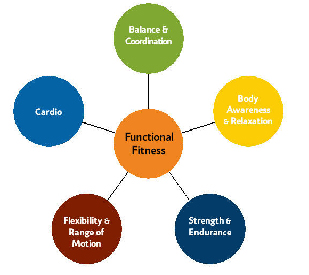|
 An Integrated Approach to Fitness An Integrated Approach to Fitness
Functional fitness maximizes the efficiency of the body’s physiological system to help manage and take care of activities of daily life. By using exercises that focus on building a body capable of doing real-life activities in real-life situations participants will make the most effective use of their time and effort. The key to a functional approach is integration. It’s about training all muscles to work together for a specific purpose rather than isolating them to work independently.
When successfully combined into the following five components of fitness, functional exercise can help maximize strength and minimize overuse of muscles that compensate for weaker counterparts and/or changes due to MS.
Strength & Endurance—Strength training uses resistance to challenge muscles, which helps improve muscle strength, bone density, muscle mass, flexibility and balance, and prevent injury. Weakness is a common problem in MS and has numerous and varied causes. A properly designed and executed physical activity program can help address areas of weakness and imbalance in the body and increase endurance during activity over time.
Flexibility & Range of Motion—Physical activity can help improve flexibility, which improves range of motion and muscle tone. For individuals living with MS, lack of movement can sometimes translate to loss of flexibility, limiting range of motion. Flexibility exercises can improve joint integrity, prevent injury and release stress.
Cardiovascular Exercise—Cardiovascular exercise, or cardio, is activity that involves the large muscles, increases the heart and respiratory rate and keeps the heart rate elevated for a period of time. Cardio is good for the heart and includes walking, bicycling, swimming, and tennis or any exercises that use large muscles. For individuals with MS, cardiovascular activity can help fight fatigue and increase endurance.
Relaxation & Body Awareness—Through purposeful breath and movement an individual can relax the body and decrease muscle tension, slow heart and respiratory rates, and shift mental attention in order to increase concentration that aids body awareness. Body awareness is a heightened consciousness of how the body moves. Such awareness can help identify and address any changes, needs or poor movement patterns in the body. By utilization of mind body techniques like those used in yoga and Tai Chi and visualization techniques like those used in Feldenkrais the body’s ability to make adjustments to movement execution processes are enhanced, possibly enabling the body to enhance its ability to adapt to its sometimes-changing ability levels as effected by MS.
Living with MS can mean change and stress. Stress depletes an individual both emotionally and physically and can add to fatigue. Physical activity acts as a form of stress management. Yoga, Tai Chi, aquatics, Pilates and Feldenkrais can be a great mind body tool for stress reduction by assisting in lowering levels of “harmful’ stress, which attacks the immune system. The purpose of relaxation is to consciously dampen physical processes through manipulation of cortical influences. This is based on the belief that the mind influences the body and the body influences the mind. What happens is that physiologically as one relaxes, muscle tension decreases (which can help reduce spasticity) the heart and respiratory rates slow, and mental attention shifts, helping to increase concentration.
Balance & Coordination—Coordination and balance involve a sequence of muscle actions to control movement. Problems with coordination and balance are quite common among people with multiple sclerosis, and result in poor posture and alignment. Exercises that promote proper posture are essential to effective body mechanics and extremely important in maintaining proper body alignment. This sequence of muscle actions rely on core muscle groups (also known as “the core”) to aid individuals to support their body weight and move with control, quality and speed. The gains in balance, control and stabilization ultimately aid walking and weight transfer movements. Poor balance and posture can create a forward flexion at the hips and add to the development of chronic back pain.
|